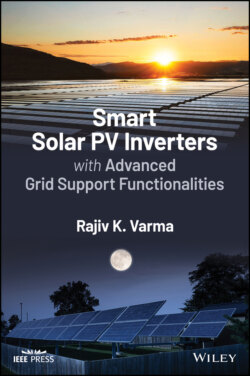Читать книгу Smart Solar PV Inverters with Advanced Grid Support Functionalities - Rajiv K. Varma - Страница 24
1.1.3.3 System Inertia
ОглавлениеSynchronous inertia is defined as “the ability of a power system to oppose changes in system frequency due to resistance provided by rotating masses” [14]. Inertia of a synchronous machine is defined as the ratio of stored kinetic energy to the MVA rating of the machine and is expressed as MW‐second/MVA, i.e. in seconds. The inertia constant effectively indicates the time duration over which the kinetic energy stored in the rotating mass will allow the production of rated output of the synchronous machine.
The system inertia, however, represents the aggregation of kinetic energy stored in the rotating masses of all the synchronous machines (generators, condensers, and motors) in the system. This system inertia provides the Synchronous Inertial Response (SIR) to arrest the system frequency as soon as the frequency starts to decline following the loss of a major generation [13].
The system inertia dictates the initial ROCOF as below [9]:
(1.6)
(1.7)
where ∆Ploss, loss in generation; KEloss, inertia of the lost generating system; KEsys, total system kinetic energy of the online synchronous machines; Hi, inertia constant of the online synchronous machine; MVAi, MVA rating of the ith online synchronous machine; I, set of all the online synchronous machines.
The above formulation demonstrates that ROCOF is directly proportional to the size of generation loss and inversely proportional to twice the SIR of the system.
In isolated microgrid environments, the relative value of active power exchanged from the DERs in comparison with the remaining generators is high. Hence, the impact of DER generation loss on microgrid system frequency is much larger than in grid‐connected environments.
It is noted that as the penetration of static IBRs (solar PV, wind generators, battery energy storage systems [BESSs]) increases in power systems, the system kinetic energy will decline.
